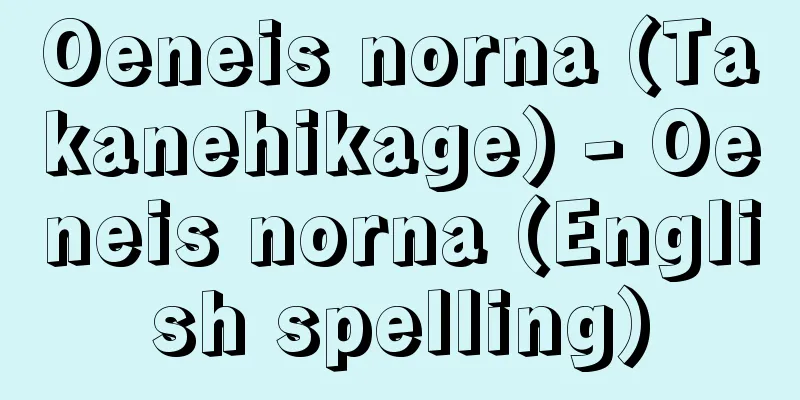Tokutomi Roka

|
Novelist. Real name Kenjiro. Born on October 25, 1868 (December 8 in the Gregorian calendar) in Minamata, Higo Province (present-day Minamata City). The Tokutomi family had been samurai for generations. Many of his relatives were outstanding figures, and he felt inferior to his older brother, Soho, for the rest of his life. He was baptized at the age of 16. At Doshisha (now Doshisha University), he fell in love with Niijima Jo's niece-in-law, but ran away when she opposed his move and returned to Kumamoto. At the age of 20, he moved to Tokyo and joined his brother's Minyusha as a journalist. After getting married, he lived a rough life due to frustration at not being able to make a living, but at the age of 29, he moved to Zushi, Kanagawa Prefecture, where he became closer to nature and his heart began to relax. Completing the manuscript of his critical biography, "Tolstoy" (1897), marked the start of his new life. In 1900 (Meiji 33), he attracted attention with the publication of "Hototogisu" and the refreshing collection of nature essays "Shizen to Jinsei" (Nature and Life), which, together with "Omoide no Ki" (Record of Memories) released the following year, became best-sellers, establishing his position as a writer. At the time, Rokujo had a tendency towards pantheism, and a common theme in his works was the liberation of life through nature, or God. He discontinued his social novel "Kuroshio" (The Current), which aimed for the liberation of the nation of Japan, after only the first volume was published (1903), and at that time he broke off relations with his brother. This abortion changed Rokujo's view of literature. In August 1905 (Meiji 38), he lost consciousness at the summit of Mount Fuji, which he took as a warning from God and converted. The following year, he made a pilgrimage to the holy site, visited Tolstoy and wrote Junrei Kiko (Junrei Kiko), and in 1907 he moved to Kasuya (Setagaya Ward, Tokyo) and started the "Biteki Hyakusho" (Aesthetic Farmer). This resulted in the collection of essays Mizu no Tahakoto (Mimizu no Tahakoto) (1913). During this time, he wrote the biographical novel Yadorigi (The Parasite Tree) (1909), and defended the defendant in the High Treason Incident in a lecture at the former First Higher School titled Muhonron (On Rebellion) (1911). After writing Kuroi Me to Brown Me (Black Eyes and Brown Eyes) (1914), which described his experience of heartbreak, he aspired to write literature that was true and that "life is art." In 1918 (Taisho 7), the year after the publication of his travelogue In the Shadow of Death, he realized that he and his wife were Adam and Eve, and published a collection of essays called New Year in which he confessed this fact. In his travelogue around the world, From Japan to Japan (1921), he went so far as to identify himself as the second coming of Christ. The couple wrote a confessional novel about their married life, From Japan to Japan, but he died of an illness on September 18, 1927 in Ikaho, Gunma Prefecture. The book was discontinued after four volumes (1925-1928). He became isolated from the literary world in his later years, and his place in literary history is also uncertain. His grave and former home are in Roka Park in Kasuya. [Masanobu Yoshida] "The Complete Works of Roka, 20 volumes (1928-30, Dosho Kankokai)" ▽ "The Complete Works of Meiji Literature 42, Tokutomi Roka Collection" (1966, Chikuma Shobo) ▽ "Roka Tokutomi Kenjiro, by Nakano Yoshio, 3 volumes (1972-74, Chikuma Shobo)" ▽ "Tokutomi Roka: Considerations and Recollections, edited by the Roka Society" (1936, Iwanami Shoten) [Reference] | |National Diet Library Tokutomi Roka This is the site of the residence where Tokutomi Roka, a great Meiji-era writer, and his wife spent the latter half of their lives. After Roka's death, his wife donated the entire estate, including the house and garden, to the city of Tokyo, and in 1928 (Showa 13), it was opened to the public as a park. The Roka Memorial Museum, built in 1959, displays some of the couple's belongings, such as personal effects, manuscripts, and letters, on display to the public. The garden, which still retains vestiges of Musashino, is also home to the couple's graves. Setagaya, Tokyo ©Yutaka Sakano "> Roka Koshunen Garden Source: Shogakukan Encyclopedia Nipponica About Encyclopedia Nipponica Information | Legend |
|
小説家。本名健次郎。明治元年10月25日(新暦では12月8日)、肥後国水俣(みなまた)(現水俣市)の生まれ。徳富家は代々郷士の家柄。親戚(しんせき)には傑物が多く、兄の蘇峰(そほう)には終生劣等感を抱いた。16歳で受洗。同志社(現同志社大学)では新島襄(にいじまじょう)の義姪(ぎてつ)と恋をし、反対されて出奔、熊本へ帰った。20歳で上京、兄の民友社に入り記者となる。結婚後、立身できないいらだちから生活はすさんだが、29歳、神奈川県逗子(ずし)へ転居し、自然に親しみ、心はほぐれていく。評伝『トルストイ』(1897)の脱稿は新生への足掛りとなった。1900年(明治33)、『不如帰(ほととぎす)』と清新な自然文集『自然と人生』の刊行によって注目され、翌年の『思出(おもいで)の記』ともどもロングセラーとなり、作家的地位を確立。当時、蘆花は汎神論(はんしんろん)的傾向にあり、自然すなわち神による人生の解脱(げだつ)が作品に共通する主題であった。日本という国家の解脱を目ざした社会小説『黒潮(くろしお)』は第1編刊行(1903)だけで中絶したが、その際、兄と決別。この中絶は蘆花の文学観を変える。 1905年(明治38)8月、富士山頂で人事不省に陥り、これを神による警鐘と受け止めて回心。翌年、聖地を巡礼、トルストイを訪ねて『順礼紀行』を著し、1907年からは粕谷(かすや)(東京都世田谷区)に移り、「美的百姓」を始めた。随筆集『みゝずのたはこと』(1913)はその所産。その間、伝記小説『寄生木(やどりぎ)』(1909)を書き、大逆事件では旧制一高での講演『謀叛論(むほんろん)』(1911)などで被告を弁護した。失恋体験を描いた『黒い眼(め)と茶色の目』(1914)以後、虚偽のない「生活即芸術」の文学を志す。紀行『死の蔭(かげ)に』刊行の翌1918年(大正7)、自分と妻をアダムとイブと自覚し、それを告白した随筆集『新春』を出し、夫妻での世界周遊紀行『日本から日本へ』(1921)では、再臨のキリストと自認するまでになる。夫妻で結婚生活の告白小説『冨士(ふじ)』を書いたが、昭和2年9月18日、群馬県伊香保(いかほ)で病死。同書は4巻(1925~1928)で中絶した。晩年は文壇から孤立。文学史的位置も未確定である。墓地と旧居が粕谷の蘆花公園にある。 [吉田正信] 『『蘆花全集』全20巻(1928~30・同書刊行会)』▽『『明治文学全集42 徳冨蘆花集』(1966・筑摩書房)』▽『中野好夫著『蘆花徳冨健次郎』全3部(1972~74・筑摩書房)』▽『蘆花会編『徳冨蘆花 検討と追想』(1936・岩波書店)』 [参照項目] | |国立国会図書館所蔵"> 徳冨蘆花 明治期の文豪徳富蘆花夫妻が後半生を過ごした邸跡。蘆花の没後、夫人が住まいや庭など旧邸地のすべてを東京市に寄贈、1928年(昭和13)に公園として公開された。1959年に建てられた蘆花記念館では、身辺具、原稿、手紙などの遺品の一部が一般に公開されている。武蔵野のおもかげが残る園内には夫妻の墓もある。東京都世田谷区©Yutaka Sakano"> 蘆花恒春園 出典 小学館 日本大百科全書(ニッポニカ)日本大百科全書(ニッポニカ)について 情報 | 凡例 |
<<: Doctrinaires (English spelling) French
Recommend
Yoshimi Takeuchi
Born: October 2, 1910, Usuda, Nagano [Died] March ...
Recreation
...the act of piling up land above the water leve...
carnem levare (English spelling) carnemlevare
...The spirit of Saturnalia, which turned the cyc...
Anatomical Manuscript
… [Manuscript - Record of Mental Activity] Of the...
Cryptanthus bromelioides (English spelling) Cryptanthusbromelioides
… [Takabayashi Masatoshi]. … *Some of the termino...
Flip - Flip
(1) Rereeling: The process of rewinding raw silk o...
Ranking - Clydori
1. To determine the place value of a number in ari...
Graf, Steffi
Born June 14, 1969, in Bruhl, Germany. Real name S...
Al-Wisba - Al-Wisba
…It is a mountain in Gwynedd (formerly Caernarvon...
Hippopotamus (English spelling) Hippopotamus amphibius; hippopotamus
It is an artiodactyl, Hippopotamidae. It is said t...
Emperor's surrender broadcast - Gyokuonhoso
This was a recorded broadcast by Emperor Showa hi...
Fishery enterprises - gyogyokigyotai
...fishing enterprises organized as companies. Ja...
Women's New Year
While the Great New Year, centered on New Year'...
Volksraad
…the Volksraad, the colonial parliament of the Du...
Python
A monster in Greek mythology. A dragon born to the...





![Sanwa [village] - Sanwa](/upload/images/67cbb7f5d7883.webp)



